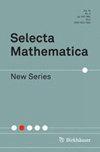四次曲面直至保持体积等值
IF 1.2
2区 数学
Q1 MATHEMATICS
引用次数: 2
摘要
摘要研究了形式为$$(\mathbb {P}^3,\Delta )$$ (p3, Δ)的对数Calabi-Yau对,其中$$\Delta $$ Δ是一个四次曲面,并对所有小于或等于1的对数Calabi-Yau对进行了分类,直到保持体积等价。特别地,如果$$(\mathbb {P}^3,\Delta )$$ (p3, Δ)是一个极大对数Calabi-Yau对,那么我们证明它具有一个环面模型。本文章由计算机程序翻译,如有差异,请以英文原文为准。

Quartic surfaces up to volume preserving equivalence
Abstract We study log Calabi–Yau pairs of the form $$(\mathbb {P}^3,\Delta )$$ ( P 3 , Δ ) , where $$\Delta $$ Δ is a quartic surface, and classify all such pairs of coregularity less than or equal to one, up to volume preserving equivalence. In particular, if $$(\mathbb {P}^3,\Delta )$$ ( P 3 , Δ ) is a maximal log Calabi–Yau pair then we show that it has a toric model.
求助全文
通过发布文献求助,成功后即可免费获取论文全文。
去求助
来源期刊
CiteScore
2.30
自引率
7.10%
发文量
68
审稿时长
>12 weeks
期刊介绍:
Selecta Mathematica, New Series is a peer-reviewed journal addressed to a wide mathematical audience. It accepts well-written high quality papers in all areas of pure mathematics, and selected areas of applied mathematics. The journal especially encourages submission of papers which have the potential of opening new perspectives.

 求助内容:
求助内容: 应助结果提醒方式:
应助结果提醒方式:


